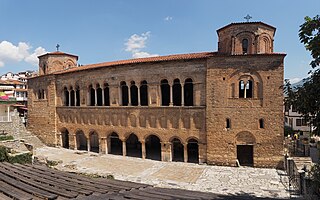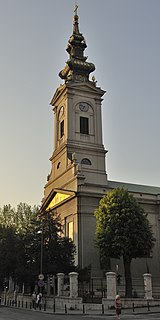
The Studenica Monastery is a 12th-century Serbian Orthodox monastery situated 39 kilometres (24 mi) southwest of Kraljevo and 40.9 kilometres (25.4 mi) east of Ivanjica, in central Serbia. It is one of the largest and richest Serb Orthodox monasteries.

The Serbian Orthodox Church is one of the autocephalous Eastern Orthodox Christian Churches. It is the second-oldest Slavic Orthodox Church in the world.

Our Lady of Ljeviš is a 14th-century Serbian Orthodox church in the town of Prizren, located in southern Kosovo. It was converted to a mosque during the Ottoman Empire and then back into a church in the early 20th century.

The Byzantine Revival was an architectural revival movement, most frequently seen in religious, institutional and public buildings. It incorporates elements of the Byzantine style associated with Eastern and Orthodox Christian architecture dating from the 5th through 11th centuries, notably that of Constantinople and the Exarchate of Ravenna. Neo-Byzantine architecture emerged in the 1840s in Western Europe and peaked in the last quarter of the 19th century in the Russian Empire, and later Bulgaria. Neo-Byzantine school was active in Yugoslavia between World War I and World War II.

The Macedonian Orthodox Church – Ohrid Archbishopric, or simply the Macedonian Orthodox Church, is the largest body of Christians in the Republic of North Macedonia. It claims ecclesiastical jurisdiction over the Republic of North Macedonia and is also represented in the Macedonian diaspora. In 1959, the Holy Synod of the Serbian Orthodox Church granted autonomy to the Macedonian Orthodox Church in the then-Socialist Republic of Macedonia as the restoration of the historic Archbishopric of Ohrid, and it remained in canonical unity with the Serbian Church under their Patriarch. In 1967, on the bicentennial anniversary of the abolition of the Archbishopric of Ohrid, the Macedonian Holy Synod unilaterally announced its autocephaly and independence from the Serbian Orthodox Church. The Serbian Holy Synod denounced the decision and condemned the clergy as schismatic. Thenceforth, the Macedonian Church has remained unrecognized by the Ecumenical Patriarchate of Constantinople and all the other canonical Orthodox churches in defense of Serbian opposition. Since May 2018 however, the Church′s status has been under examination by the Ecumenical Patriarchate of Constantinople. The primate of the Macedonian Orthodox Church is the Metropolitan of Skopje and Archbishop of Ohrid and Macedonia and of Justiniana Prima.

The Greek Catholic Church of Croatia and Serbia is a particular Eastern Catholic Church of the Byzantine Rite which is in full union with the Catholic Church. It consists of the Greek Catholic Eparchy of Križevci, covering Croatia, Slovenia, and Bosnia-Herzegovina, and the Greek Catholic Eparchy of Ruski Krstur, covering Serbia. The Eparchy of Križevci was headed by Bishop Nikola Kekić until his retirement in March 2019, and since then the eparchy is governed by apostolic administrator Milan Stipić. The Eparchy of Ruski Krstur is headed by Bishop Đura Džudžar since his appointment in 2003.

The Patriarchate of Peć Monastery or Patriarchal Monastery of Peć, is a medieval Serbian Orthodox monastery located near the city of Peć, in Kosovo. Built in the 13th century, it became the residence of Serbian Archbishops. It was expanded during the 14th century, and in 1346, when the Serbian Patriarchate of Peć was created, the Monastery became the seat of Serbian Patriarchs. Monastery complex consists of several churches, and during medieval and early modern times it was also used as mausoleum of Serbian archbishops and patriarchs. Since 2006, it is part of the "Medieval Monuments in Kosovo", a combined World Heritage Site along with three other monuments of the Serbian Orthodox Church.

The Cathedral Church of St. Michael the Archangel is a Serbian Orthodox cathedral church in the centre of Belgrade, Serbia, situated in the old part of the city, at the intersection of Kralja Petra and Kneza Sime Markovića streets. It was built between 1837 and 1840, on the location of an older church also dedicated to Archangel Michael. It is one of the most important places of worship in the country. It is commonly known as just Saborna crkva among the city residents. It was proclaimed as a Cultural Monument of Exceptional Importance in 1979.

The architecture of Serbia has a long, rich and diverse history. Some of the major European style from Roman to Post Modern are demonstrated, including renowned examples of Raška, Serbo-Byzantine with its revival, Morava, Baroque, Classical and Modern architecture, with prime examples in Brutalism and Art Moderne.

Zagreb Orthodox Cathedral or Cathedral of the Transfiguration of the Lord is a Serbian Orthodox Cathedral located on the Petar Preradović Square in Zagreb, Croatia. It was built in 1865–66 according to designs of architect Franjo Klein. It is ecclesiastically part of the Metropolitanate of Zagreb and Ljubljana and its cathedral.

The Church of St. Achillius, or the Arilje Monastery is a Serbian Orthodox church in Arilje, western Serbia. It is dedicated to Saint Achillius of Larissa, a fighter against Arianism and participant of the First Council of Nicaea in 325. The church was built in 1296 by Serbian King Stefan Dragutin of the Nemanjić dynasty and is located in the center of town, on the elevated plateau above the large river valley and the river Moravica and Big Rzav, and represents the most dominant object in the Arilje region.

The Church of the Holy Apostles Peter and Paul, commonly known as Church of St Peter or simply Peter's Church is a Serbian Orthodox church, the oldest intact church in Serbia and one of the oldest ones in the region, situated on a hill of Ras, the medieval capital of the Serbian Grand Principality (Rascia), in Novi Pazar, Serbia. It is part of the Stari Ras complex, an UNESCO World Heritage Site.

The Catholic Church has a population in Kosovo of approximately 65,000 in a region of roughly 2 million people. Another 60,000 Kosovar Catholics are outside the region, mainly for work. They are mainly ethnic Albanians, with a few Croats.

Irinej is the 45th Patriarch of the Serbian Orthodox Church, the spiritual leader of Eastern Orthodox Serbs, since 22 January 2010. His full title is His Holiness the Archbishop of Peć, Metropolitan of Belgrade and Karlovci, and Serbian Patriarch Irinej. He served as the Bishop of Niš between 1975 and 2010.

The Saints Constantine and Helen Serbian Orthodox Church is a Serbian Orthodox church located in Galveston, Texas, United States. It is a parish of the Serbian Orthodox Diocese of New Gracanica - Midwestern America.

The Serbian Orthodox Diocese of Canada is a Serbian Orthodox Church diocese located in Canada. Its headquarters are in Campbellville, Milton, Ontario. Its current primate is Bishop Mitrofan (Kodić). The Holy Transfiguration Monastery is located on the episcopal grounds.
Joannicius III, was Archbishop of Peć and Serbian Patriarch from 1739 to 1746 and Archbishop of Constantinople and Ecumenical Patriarch from 1761 to 1763. The ordinal number of his title is III both for his office as Serbian Patriarch and of Constantinople.

Saint Sava, known as the Enlightener, was a Serbian prince and Orthodox monk, the first Archbishop of the autocephalous Serbian Church, the founder of Serbian law, and a diplomat. Sava, born as Rastko, was the youngest son of Serbian Grand Prince Stefan Nemanja, and ruled the appanage of Hum briefly in 1190–92. He then left for Mount Athos, where he became a monk with the name Sava (Sabbas). At Athos he established the monastery of Hilandar, which became one of the most important cultural and religious centres of the Serbian people. In 1219 the Patriarchate exiled in Nicea recognized him as the first Serbian Archbishop, and in the same year he authored the oldest known constitution of Serbia, the Zakonopravilo nomocanon, thus securing full independence; both religious and political. Sava is regarded as the founder of Serbian medieval literature.

Banja Monastery is a Serbian Orthodox Monastery located near Priboj, Serbia. Monastery Banja presents Cultural Monument of Exceptional Importance in Serbia.



















